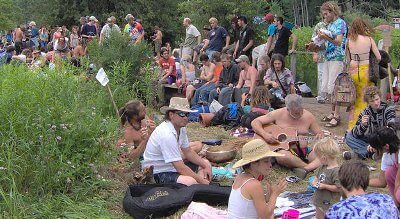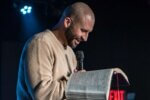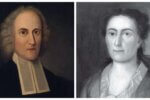Every year a ragtag group of American misfits gather in the forest to live in peace with nature. But some equally radical Christians are introducing them to the message of Jesus.
Welcome home brother. It’s been too long,” says Rolf, a dirty 50-something clad in greasy cutoff shorts and sockless loafers. His current residence is in a stretch of Idaho wilderness among an eclectic group of hippies, Vietnam War veterans, anti-war protesters and runaway teens. Right now, Rolf is standing in the A camp, aptly named for the alcoholics who gather there to drink and party.
From the camp next door, a woman’s screams pierce the warm summer air. Free Indeed Ministries’ blue plastic tarp offers relief from the sun, but just outside it, pastor Dan Grether and his wife, Robby, help this young woman find a different kind of relief as they pray for her deliverance. Her hands lifted, the woman lets out another dreadful shriek as the pastors continue to pray.
Sights and sounds such as these are anything but unusual in this commune of Rainbow People, an odd assortment of protesters, alcoholics, homeless people, fugitives and drug addicts. Fiercely distrustful of the government and any other entity that seeks to control or exploit the planet, these Rainbow families settle in forests, live off the land and pray for world peace.
At this year’s annual gathering of the Rainbow Family, held in the Boise National Forest in Idaho on July 4, a 50-acre makeshift parking lot is jammed with colorfully painted buses, campers and a smattering of sport utility vehicles. Roughly 20,000 dusty travelers have journeyed from across the nation to attend this unusual family reunion.
Their vehicles are peppered with bumper stickers proselytizing their anti-establishment gospel: “Don’t follow leaders”; “God bless the freaks”; “Jesus was a hippie”; and “Reality is for people who lack imagination.”
Incessant streams of welcome banners hang overhead, while signs plastered throughout the camp encourage the “family members” assembled to go easy on the environment: “Vanish all traces. Harm no living thing. Harmonize. Blend in.” It’s a lofty goal in this sensitive 7,000-foot-high mountain meadow. But the Rainbows work hard to bury waste, protect the water and pack out litter.
Drawing from a variety of religions, including New Age spiritism, they seek love, freedom and a sense of belonging. Though observers often misunderstand the Rainbows’ eclectic lifestyles, Christians are at work among them, reaching the Rainbow People with servant evangelism and a nonthreatening gospel message that points this forgotten mission field toward the ultimate source of love and peace.
A Rainbow-Colored World
As the day dawns, granite peaks glow in the early morning light, and the relentless beating of drums has finally ceased. The forest is quiet, save the soft gurgling of small creeks meandering through flower-filled meadows.
This Rainbow-colored world, nestled 20 miles from the closest paved road and a hundred miles north of Boise, Idaho, seems an unlikely spot to call home. Cache Creek Meadows in the Bear Creek Wilderness may have looked this way when the intrepid explorers Meriwether Lewis and William Clark stumbled across the nearby Bitterroot Mountains nearly 200 years ago.
Purple, yellow and white flowers accentuate the dull green sagebrush. Mountain bluebirds and starlings chirp nearby. The sweet fragrance of ponderosa and jack pine fill the pure mountain air.
At night, the smoke from a hundred campfires rises slowly and then lingers in the air as if it has no place to go. The eerie sound of drumming drifts across the star-studded summer sky. Dogs bark, people sing and raucous laughter erupts amid the gathering of friends. The countercultural Rainbow People have no formal leadership, no rules and no headquarters.
This nearly 30-year-old event is where the Rainbow “sisters and brothers feed their souls.” While demographics are hard to come by, about one-fifth of the Rainbows are older hippies. The rest are in their late teens to mid-20s–a group that is often disenfranchised from society and disinterested in the ebb and flow of the stock market.
Hand-hewn lodge-pole pines are held in place by twine so family members can ford the meandering clear-water streams. Most of the camps are a half-mile or more from the parking area. A mother and daughter stagger by, offering a hand-rolled marijuana cigarette as they stare out with blank expressions on their faces. A naked man wanders aimlessly through a meadow. Coed “showers” offer relief from the blazing summer sun.
A mirror dangles like a wind chime from a tree. Underneath is a piece of cardboard that reads, “Your secret leader.” Individual camps and “kitchens” with names such as “Airhead Café,” “Brew-Ha-Ha,” “Dew Drop In” and “Spawnteweyous Eggspressyon” abound in the wide-open space. Like a scene out of Alice in Wonderland, there is a “Faerie Camp” for gays and lesbians, a “Fattie Camp” for the overweight, a “Kiddie Village” for children and even a “Pagan Camp.”
Practicing a “live and let live” philosophy, the Rainbow People are open, caring, giving, loving, nonjudgmental–and searching for spiritual truth. As one posting suggests, they can also be a bit eccentric: “Gutter hippie seeks fellow dragons to spin into universal head space. Fellow Aquarians to bounce off the trees of reality. Protectors of the bliss.”
Most Rainbows have little or no earthly goods. They share instead, embracing the mantra: “Everyone sharing makes a strong human tribe.”
To outsiders, members of the Rainbow People may seem like rebellious panhandlers who need a bath. They are an odd assortment of individual tastes and styles–long hair, dreadlocks, Mohawks, pierced skin, tattoos and dangling trinkets. Not unlike the hippies of the 1960s, they are non-establishment, tout community, and believe in love, peace and brotherhood. Yet every Rainbow is searching for the same thing–a place to belong.
In a culture rife with broken families, unwanted children and rejection, it comes as little surprise that Rainbow culture should attract so many “family members” to a mountaintop gathering. Fortunately, a few Christians have found their way into these woods, too.
Miracles in the Woods
Twenty-five-year-old Caroline looks part gypsy, part New Ager. She knows more about the spirit world than many Christians and doesn’t debate whether the forces of good and evil are real. Caroline knows firsthand there is a battle being waged for her soul. Ever since she accepted Christ four days ago, she has been a target of malevolent forces.
“Before I came here, I believed in New Age spiritualism,” she says. She was convinced by Arjune, a New Age mystic from San Francisco, to make the pilgrimage.
In a prayer circle of 50 believers and Rainbows, Caroline talks about her struggles–and her deliverance. Tears flow freely down her face as she shares her intimate struggles with a group of caring Christians she hardly knows.
“I have so many battles, so many struggles. There are so many obstacles,” she says. “I feel like a warrior.”
God was preparing Caroline’s heart before she even knew it. In a dream, she says, she went to see her New Age mother about the enormous oppression she was under. But in the dream her “mother” ignored her, and Caroline felt more alone than ever.
As she left her home, she recalls, a friend named Salvador came to her and provided hope and comfort. “It was then that I realized what God was saying to me. Salvador in Spanish means ‘savior.’ When I awoke from my dream, I knew that Jesus wanted to be my Savior.”
Caroline made her way to the Bread of Life camp run by pastor Chuck Parry of Telluride, Colorado, and Parry began to pray with her. As he and several Christians laid hands on her, she says: “I felt such overwhelming joy, such a sense of freedom. I didn’t feel that I was worthy to see Jesus.”
Then suddenly she smelled roses, something she thought was part of the salvation experience. Later that night she burned her diary and sandals in the campfire–similar to what the sorcerers in Ephesus did in the book of Acts (see 19:18-20) after they converted.
But as she prepared to sleep that night, Caroline says, a powerful force began putting pressure on her face. Caroline felt evil nearby.
“[I said], ‘Jesus, please don’t let this enter my tent,'” she recalls.
She says a silent, dark-eyed man tried to come in her tent. She asked his name, and he said, “Carlos.”
“I began speaking the name, ‘Jesus, Jesus, Jesus,'” and Carlos finally backed away. In Spanish, [Carlos] means ‘warrior.'”
Though her knowledge of Scripture is limited, Caroline knows she wasn’t wrestling with “flesh and blood” but was experiencing spiritual warfare, as described in Ephesians 6.
“We are not warriors of war,” she says, “we are warriors of the cross. I knew there was some kind of darkness in me. I just didn’t know where to find peace. Now I do!”
Chuck Parry has been coming to Rainbow gatherings since 1992. His Bread of Life kitchen was the first ministry to the Rainbows (soon followed by the Jesus Kitchen out of Minneapolis).
Each day Parry walks the one-acre perimeter of his camp and invites the presence of God. This year, he and his wife, Linda, secured 100 volunteers to serve meals, run water lines, lead worship teams and pray.
A thoughtful, articulate man of the Word, Parry has witnessed scenes most ministers never even imagine. This year, members of the Pagan Camp sent naked emissaries into the Bread of Life camp. Later, two witches and a warlock walked in and wanted to join the worship team.
Then a man who looked like an African witch doctor–clad with feathers and rattles–wandered into the Bread of Life kitchen. A member of Parry’s team simply asked the man if he would like to give his life to Jesus. The man fell to his knees and said, “I do.”
God’s Rainbow Promise
Christian ministers working among the Rainbow people believe God is at work in ways that even they don’t see. They say it is no coincidence that every year since 1972 members of the Rainbow Family have met in national forests. While the forests offer isolation, they also provide a glimpse into God’s bountiful creation.
The ragtag band of evangelists cite Romans 1:20, which says, “His invisible attributes are clearly seen, being understood by the things that are made” (NKJV).
Parry says God used a magnificent sunset in the main meadow to draw attention away from a naked man who walked up and spit on a cross during an evening “council of Christian camps.”
“Our focus needed to be on worshiping God, and He knew the best way to get our attention,” Parry says.
Tedd Craven, a 39-year-old missionary to the Rainbows, believes God has a prophetic plan for the Rainbow People that parallels what He wanted to do through His chosen people, Israel.
“Everything God is doing is prophetic,” he told Charisma. “Even their name comes from one of God’s promises. I am confident this people group is a group set apart to the Lord. Soon many will enter the ark.”
Craven says hundreds of youth committed their lives to Jesus at this year’s gathering. He says the Rainbow People are searching for truth, not religion, and Jesus is meeting them in their pain.
Although the gathering was spread out across a 10-square-mile area, it was easy to find Christians doing ministry much like first-century believers did. Some were laying hands on those who needed a touch from God. Others were carrying loads of water, singing praises or discipling new believers.
Ministers here say the Rainbow People are very open to the miraculous. “There is enormous spiritual energy at the Rainbow gathering,” Parry says.
The spiritually charged atmosphere is palpable–a strange mix of God’s presence in the midst of darkness and sin. Chris Ward, a 53-year-old Vietnam War veteran known as “2 Hawks,” prays with fervor and compassion for 6-1/2-foot David, who wants God’s help to land a job and live for Christ after the Rainbow gathering comes to an end.
Ward is no stranger to this mission field. He and 31-year-old Brian Cronin are authors of The Phat News of Mark, a translation of the Gospel of Mark that is written in hippie terms. The pair is among the 18 Christian ministries that have come to reach out to the Rainbows in Jesus’ name.
“Deliverance ministry is not something we debate here,” Ward says. “It is not theory.”
He says the Rainbow gatherings exhibit the heart of the charismatic movement. “The forces of evil are out front. Yet when these kids are saved, they act like charismatics–dancing, evangelizing and taking God at His word.”
Cronin describes the Rainbow People as “lovers of God. They see us demonstrating the love of Jesus out here.”
The various Christian ministries dispense hundreds of meals a day through their makeshift kitchens. They pray for the sick, provide cold water, socks, shampoo and even offer basic medical help.
“The Rainbow Family is beginning to see Christians as those who care and not those who condemn,” Craven says. “The whole atmosphere is changing.”
For ex-Rainbows such as Cronin, the presence of so many Christian groups is a welcome sight. “They see us demonstrating the love of Jesus. There are no denominations here.”
Like many of the Rainbow kids today, Cronin was drawn to his first gathering because of the acceptance and sense of community. He immediately started “getting plugged in” by chopping wood, hauling water and doing whatever he could to help others. But there was still a place of emptiness within his soul that drugs, sex and even community could not fill.
After three family members died, Cronin began to call out to God–praying for protection on the rest of his family. God answered his prayer and brought him to faith in Christ.
The Rainbow guide says “a week at a national gathering will change you in a good way. The effect is profound.” Dan Grether, a 56-year-old pastor from Spokane, Washington, agrees.
“It changed me. I knew we would come home and see all kinds of needy people around us,” Grether says. “People are more open to hearing the gospel than I thought.”
Still, there is plenty of work for caring believers to do. Those who are willing to give up their risk-free Christianity will find the fields ripe unto harvest.
“When these Rainbow kids are saved,” Ward says, “they take the Bible literally. They believe what they read.”
This kind of radical acceptance of God’s Word and a willingness to die to the things of this world are combustible ingredients for a move of God. The sign of the rainbow is a reminder of God’s covenant to save and not destroy–and His promise includes the children of the Rainbow.
Don S. Otis is author of Staying Fit After Forty (Shaw), Teach Your Children Well (Revell) and Trickle-Down Morality (Chosen). He and his wife, Susan, and their three teenage boys live in Sandpoint, Idaho.







Leave a Comment
You must be logged in to post a comment.